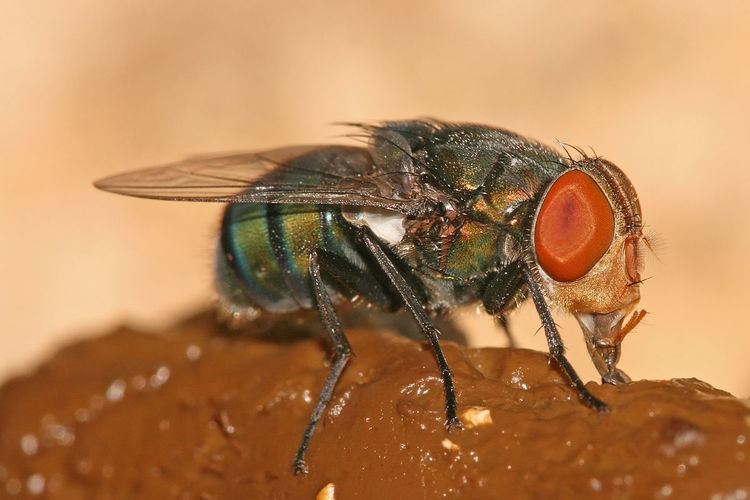 | ||
Coprophagia /kɒp.rə.ˈfeɪ.dʒi.ə/ or coprophagy /kəˈprɒfədʒiː/ is the consumption of feces. The word is derived from the Greek κόπρος copros, "feces" and φαγεῖν phagein, "to eat". Coprophagy refers to many kinds of feces-eating, including eating feces of other species (heterospecifics), of other individuals (allocoprophagy), or one's own (autocoprophagy) – those once deposited or taken directly from the anus.
Contents
In humans, coprophagia has been observed in individuals with mental illness. Some animal species eat feces as a normal behavior; other species may not normally consume feces but do so under very unusual conditions.
Humans
Coprophagia has been observed in individuals with schizophrenia and pica.
Invertebrates
Coprophagous insects consume and redigest the feces of large animals. These feces contain substantial amounts of semi-digested food, particularly in the case of herbivores, owing to the inefficiency of the large animals' digestive systems. Two feces-eating insects are the dung-beetle and certain species of fly.
Termites eat one another's feces as a means of obtaining their hindgut protists. Termites and protists have a symbiotic relationship (e.g. with the protozoan that allows the termites to digest the cellulose in their diet). For example, in one group of termites, there is a three-way symbiotic relationship: termites of the family Rhinotermitidae, cellulolytic protists of the genus Pseudotrichonympha in the guts of these termites, and intracellular bacterial symbionts of the protists.
Vertebrates
Domesticated and wild mammals are known to consume feces. In the wild they either bury or eat waste to protect their trail from predators. Mothers of certain species are known to eat the feces of their newborn young during the earliest phase after birth, presumably to eliminate cues to potential predators and to keep the den clean.
Dogs may be coprophagic, possibly to rebalance their microbiome or to ingest missing nutrients.
Species within the Lagomorpha (rabbits, hares, and pikas) produce two types of fecal pellets: hard ones, and soft ones called cecotropes. Animals in these species reingest their cecotropes, to extract further nutrients. Cecotropes derive from chewed plant material that collects in the cecum, a chamber between the large and small intestine, containing large quantities of symbiotic bacteria that help with the digestion of cellulose and also produce certain B vitamins. After excretion of the soft cecotrope, it is again eaten whole by the animal and redigested in a special part of the stomach. The pellets remain intact for up to six hours in the stomach; the bacteria within continue to digest the plant carbohydrates. This double-digestion process enables these animals to use nutrients that they may have missed during the first passage through the gut, as well as the nutrients formed by the microbial activity and thus ensures that maximum nutrients are derived from the food they eat. This process serves the same purpose within these animals as rumination (cud-chewing) does in cattle and sheep.
Cattle in the United States are often fed chicken litter. There are concerns that the practice of feeding chicken litter to cattle could lead to bovine spongiform encephalopathy (mad-cow disease) because of the crushed bone meal in chicken feed. The U.S. Food and Drug Administration regulates this practice by attempting to prevent the introduction of any part of a cow's brain or spinal cord into livestock feed. Other countries, like Canada, have banned chicken litter for use as a livestock feed.
The young of elephants, giant pandas, koalas and hippos eat the feces of their mothers or other animals in the herd, in order to obtain the bacteria required to properly digest vegetation found in their ecosystems. When such animals are born, their intestines are sterile and do not contain these bacteria. Without doing this they would be unable to obtain any nutritional value from plants.
Hamsters, guinea pigs, chinchillas and naked mole-rat eat their own droppings, which are thought to be a source of vitamins B and K, produced by gut bacteria. Gorillas have been recorded to consume their feces extremely rarely, possibly out of boredom, a desire for warm food, or to reingest seeds contained in the feces.
Pigs sometimes eat the feces of herbivores that leave a significant amount of semi-digested matter, including their own. In some cultures it was common for poor families to collect horse feces to feed their pigs, which contributes to the risk of parasite infection.The pig toilet is an application of porcine coprophagy to human sanitation.
Plants
Some carnivorous plants, such as pitcher plants of the genus Nepenthes, obtain nourishment from the feces of commensal animals.
History
Lewin reported that "... consumption of fresh, warm camel feces has been recommended by Bedouins as a remedy for bacterial dysentery; its efficacy (probably attributable to the antibiotic subtilisin from Bacillus subtilis) was anecdotally confirmed by German soldiers in Africa during World War II".
Centuries ago, physicians tasted their patients' feces, to better judge their state and condition.
Society and culture
Coprophagia is depicted in pornography, usually under the term scat (from scatology).
The 120 Days of Sodom, a novel by the Marquis de Sade written in 1785, is full of detailed descriptions of erotic sadomasochistic coprophagia. Thomas Pynchon's award-winning 1973 novel Gravity's Rainbow contains a detailed scene of coprophagia. François Rabelais, in his classic Gargantua and Pantagruel, often employs the expression mâche-merde or mâchemerde, meaning shit-chewer. This in turn comes from the Greek comedians Aristophanes and particularly Menander, who often use the term skatophagos (σκατοϕάγος). The Austrian actor and pornographic director Simon Thaur created the series "Avantgarde Extreme" and "Portrait Extrem", which explores coprophagy, coprophilia and urophagia. Modern Russian writer Vladimir Sorokin's novel Norma describes a society where coprophagia is institutionalised and mandatory. The comic book author Kalem Enginar used the Turkish name for a feces-eating fly, the Ferdogan, as a character in his graphic novel Dark Lightbulbs.
